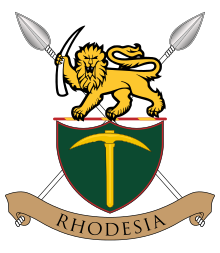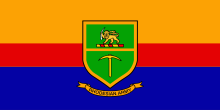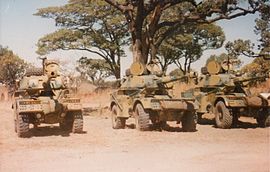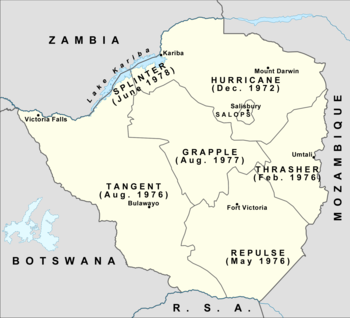
A | B | C | D | E | F | G | H | CH | I | J | K | L | M | N | O | P | Q | R | S | T | U | V | W | X | Y | Z | 0 | 1 | 2 | 3 | 4 | 5 | 6 | 7 | 8 | 9
| Rhodesian Security Forces | |
|---|---|
 Emblem of the Rhodesian Army. Following the declaration of a republic in 1970, St Edward's Crown was removed. | |
| Founded | 1964 |
| Disbanded | 1980 |
| Service branches | |
| Headquarters | Salisbury |
| Leadership | |
| Commander-in-Chief | See list |
| Minister of Defence | See list |
| Head of the Rhodesian Armed Forces | See list |
| Related articles | |
| History | Rhodesian Bush War |
| Ranks | Military ranks |
The Rhodesian Security Forces were the military forces of the Rhodesian government. The Rhodesian Security Forces consisted of a ground force (the Rhodesian Army), the Rhodesian Air Force, the British South Africa Police, and various personnel affiliated to the Rhodesian Ministry of Internal Affairs. Despite the impact of economic and diplomatic sanctions, Rhodesia was able to develop and maintain a potent and professional military capability.[1]
The Rhodesian Security Forces of 1964–80 traced their history back to the British South Africa Company armed forces, originally created during company rule in the 1890s. These became the armed forces of the British self-governing colony of Southern Rhodesia on its formation in 1923, then part of the Federation of Rhodesia and Nyasaland military in 1953. After the break-up of the Federation at the end of 1963, the security forces assumed the form they would keep until 1980.
As the armed forces of Rhodesia (as Southern Rhodesia called itself from 1964), the Rhodesian Security Forces remained loyal to the Salisbury government after it unilaterally declared independence from Britain on 11 November 1965. Britain and the United Nations refused to recognise this, and regarded the breakaway state as a rebellious British colony throughout its existence.
The security forces fought on behalf of the government against the Zimbabwe African National Liberation Army and the Zimbabwe People's Revolutionary Army—the military wings of the Marxist–Leninist black nationalist Zimbabwe African National Union and Zimbabwe African People's Union respectively—during the Rhodesian Bush War of the 1960s and 1970s.
The Lancaster House Agreement and the return of Rhodesia to de facto British control on 12 December 1979 changed the security forces' role altogether; during the five-month interim period, they helped the British governor and Commonwealth Monitoring Force to keep order in Rhodesia while the 1980 general election was organised and held. After the internationally recognised independence of Zimbabwe in April 1980, the Rhodesian security forces, the Zimbabwe African National Liberation Army and the Zimbabwe People's Revolutionary Army were integrated to form the new Zimbabwe Defence Forces. Around 5,000 Rhodesian military and intelligence personnel were recruited by South Africa in 1980 as part of Operation Winter.
Rhodesian Army
| Rhodesian Army | |
|---|---|
 Flag of the Rhodesian Army, used during the late 1970s. | |
| Active | 1927–1980 |
| Disbanded | 18 April 1980 |
| Country | |
| Allegiance | |
| Branch | Ground forces |
| Garrison/HQ | Salisbury |
| Colors | Rifle green |
| Engagements | World War I World War II Rhodesian Bush War |
| Insignia | |
| Shoulder flash & recruitment logo |  |

The majority of the Southern Rhodesia Volunteers were disbanded in 1920 for reasons of cost, the last companies being disbanded in 1926. The Defence Act of 1927 created a Permanent Force (the Rhodesian Staff Corps) and a Territorial Force as well as national compulsory military training.[2] With the Southern Rhodesia Volunteers disbanded in 1927, the Rhodesia Regiment was reformed in the same year as part of the nation's Territorial Force. The 1st Battalion was formed in Salisbury with a detached "B" company in Umtali and the 2nd Battalion in Bulawayo with a detached "B" Company in Gwelo.[3] Between the World Wars, the Permanent Staff Corps of the Rhodesian Army consisted of only 47 men. The British South Africa Police were trained as both policemen and soldiers until 1954.[4]
About 10,000 white Southern Rhodesians (15% of the white population) mustered into the British forces during the Second World War, serving in units such as the Long Range Desert Group, the Rhodesian Armoured Corps, No. 237 Squadron RAF and the Special Air Service (SAS). Pro rata to population, this was the largest contribution of manpower by any territory in the British Empire, even outstripping that of Britain itself. Southern Rhodesia was in fact the first Commonwealth country to officially declare war on the Axis powers.[5]
Southern Rhodesia's own units, most prominently the Rhodesian African Rifles (made up of black rank-and-filers and warrant officers, led by white officers; abbreviated RAR), fought in the war's East African Campaign and in Burma.[6] During the war, Southern Rhodesian pilots proportionally earned the highest number of decorations and ace appellations in the Empire. This resulted in the Royal Family paying an unusual state visit to the colony at the end of the war in thanks to the efforts of the Rhodesian people.[citation needed]
The Southern Rhodesia Air Force (SRAF) was re-established in 1947 and, two years later, Prime Minister Sir Godfrey Huggins appointed a 32-year-old South African-born Rhodesian Spitfire pilot, Ted Jacklin, as air officer commanding tasked to build an air force in the expectation that British African territories would begin moving towards independence, and air power would be vital for land-locked Southern Rhodesia. The threadbare SRAF bought, borrowed or salvaged a collection of vintage aircraft, including six Tiger Moths, six North American Harvard trainers, an Avro Anson freighter and a handful of De Havilland Rapide transport aircraft, before purchasing a squadron of 22 Mk. 22 war surplus Supermarine Spitfire from the Royal Air Force (RAF) which were then flown to Southern Rhodesia.[7]
In April 1951, the defence forces of Southern Rhodesia were completely reorganised.[8] The Permanent Force included the British South Africa Police as well as the Southern Rhodesia Staff Corps, charged with training and administering the Territorial Force. The SRAF consisted of a communication squadron and trained members of the Territorial Force as pilots, particularly for artillery observation. During the Malayan Emergency of the 1950s, Southern Rhodesia contributed two units to the Commonwealth's counter-insurgency campaign: the newly formed Rhodesian SAS served a two-year tour of duty in Malaya starting in March 1951,[9] then the Rhodesian African Rifles operated for two years from April 1956.[10]
The colony also maintained women's auxiliary services (later to provide the inspiration for the Rhodesia Women's Service), and maintained a battalion of the RAR, officered by members of the Staff Corps. The Territorial Force remained entirely white and largely reproduced the Second World War pattern. It consisted of two battalions of the Royal Rhodesia Regiment, an Armoured Car Regiment, Artillery, Engineers, Signal Corps, Medical Corps, Auxiliary Air Force and Transport Corps. In wartime the country could also draw on the Territorial Force Reserve and General Reserve. Southern Rhodesia, in other words, reverted more or less to the organisation of the Second World War.
Matters evolved greatly over twenty years. The regular army was always a relatively small force, but by 1978–79 it consisted of 10,800 regulars nominally supported by about 40,000 reservists. While the regular army consisted of a professional core drawn from the white population (and some units, such as the Rhodesian SAS and the Rhodesian Light Infantry, were all-white), by 1978–79 the majority of its complement was actually composed of black soldiers. The army reserves, in contrast, were largely white.[11]
The Rhodesian Army HQ was in Salisbury and commanded over four infantry brigades and later an HQ Special Forces, with various training schools and supporting units. Numbers 1,2, and 3 Brigade were established in 1964 and 4 Brigade in 1978.[12]
- 1 Bde – Bulawayo with area of responsibility in Matabeleland
- 2 Bde – Salisbury with area of responsibility in Mashonaland
- 3 Bde – Umtali with area of responsibility in Manicaland
- 4 Bde – Fort Victoria with area of responsibility in Victoria province
During the Bush War, the army included:
- Army Headquarters
- The Rhodesian Light Infantry
- C Squadron (Rhodesian) SAS (in 1978 became 1 (Rhodesian) Special Air Service Regiment)
- Selous Scouts
- The Rhodesian Armoured Car Regiment (The Black Devils)
- Grey's Scouts

Eland-90 armoured cars of the Rhodesian Armoured Corps. - The Rhodesian African Rifles
- The Rhodesia Regiment (eight battalions, numbered 1, 2, 4, 5, 6, 8, 9, 10); also National Service independent companies numbered 1–6 and, briefly, 7), though at times one or more of these independent companies were attached to the RAR during the Bush War.[13] [14]
- Psychological Action Group (Psyac)
- The Rhodesian Defence Regiment (two battalions)
- The Rhodesian Intelligence Corps
- The Rhodesian Artillery (one depot, one field regiment)
- Six Engineer Squadrons (numbered 2, 3, 4, 6, 7) 1 Engr Sqn
- 5 Engineer Support Squadron
- 1 Brigade[15]
- Headquarters Abbreviation: HQ 1 Bde
- Signals Squadron Abbreviation: 1(Bde) Sig Sqn
- 2 Brigade[15]
- Headquarters Abbreviation: HQ 2 Bde
- Signals Squadron Abbreviation: 2(Bde) Sig Sqn
- 12 Signals Squadron Abbreviation: 2(Bde) 12 Sig Sqn[16]
- Located: Llewellyn Barracks
- 12 Signals Squadron Abbreviation: 2(Bde) 12 Sig Sqn[16]
- 3 Brigade[15]
- Headquarters Abbreviation: HQ 3 Bde
- Signals Squadron Abbreviation: 3(Bde) Sig Sqn
- 4 Brigade[15]
- Headquarters Abbreviation: HQ 4 Bde
- 41 Troop, Signals Squadron Abbreviation: 41 Tp 4(Bde) SigSqn
- Two Services Area HQs (Matabeleland and Mashonaland)
- Two Ordnance and Supplies Depots (Bulawayo, Salisbury)
- Two Base Workshops (Bulawayo, Salisbury)
- 1 Air Supply Platoon
- Three Maintenance Companies (numbered 1 to 3)
- Three Medical Companies (1, 2, 5) and the Army Health Unit
- Tsanga Lodge
- Five Provost Platoons (numbered 1 to 5) and the Army Detention Barracks
- Six Pay Companies (numbered 1 to 5, 7)
- Rhodesian Army Education Corps
- Rhodesian Corps of Chaplains
- Army Records, and Army Data Processing Unit
- Rail Transport Organisation Platoon
- 1 Military Postal Platoon
- Training establishments: School of Infantry, 19 Corps Training Depot, School of Military Engineering, School of Signals, Services Training School, Services Trade Training Centre, Medical Training School, School of Military Police, Pay Corps Training School, School of Military Administration.
- Rhodesian Women’s Service
Ranks
| Rank group | General / flag officers | Senior officers | Junior officers | Officer cadet | ||||||||||||||||||||||||||||||||
|---|---|---|---|---|---|---|---|---|---|---|---|---|---|---|---|---|---|---|---|---|---|---|---|---|---|---|---|---|---|---|---|---|---|---|---|---|

|

|

|

|

|

|

|

|

|
||||||||||||||||||||||||||||
| Lieutenant general | Major general | Brigadier | Colonel | Lieutenant Colonel | Major | Captain | Lieutenant | Second Lieutenant | ||||||||||||||||||||||||||||
| Rank group | Senior NCOs | Junior NCOs | Enlisted | |||||||||||||||||||||||||||||||||
|---|---|---|---|---|---|---|---|---|---|---|---|---|---|---|---|---|---|---|---|---|---|---|---|---|---|---|---|---|---|---|---|---|---|---|---|---|

|

|
No insignia | ||||||||||||||||||||||||||||||||||
| Warrant Officer Class 1 | Warrant Officer Class 2 | Staff Sergeant | Sergeant | Corporal | Lance Corporal | Private (or equivalent) | ||||||||||||||||||||||||||||||
Rhodesian Air Force
The Royal Rhodesian Air Force (RRAF), as it was named in 1954, was never a large air force. In 1965, it consisted of only 1,200 regular personnel. It was renamed as the Rhodesian Air Force (RhAF) in 1970. At the peak of its strength during the Bush War, it had a maximum of 2,300 personnel of all races, but of these, only 150 were pilots actively involved in combat operations. These pilots, however, were rotated through the various squadrons partly to maintain their skills on all aircraft and partly to relieve fellow pilots flying more dangerous sorties.
Ranks
| Rank group | General/Flag/Air officers | Senior officers | Junior officers | Officer cadet | ||||||||||||||||||||||||||||||||
|---|---|---|---|---|---|---|---|---|---|---|---|---|---|---|---|---|---|---|---|---|---|---|---|---|---|---|---|---|---|---|---|---|---|---|---|---|

|

|

|

|

|

|

|

|

| ||||||||||||||||||||||||||||
| Air Marshal | Air Vice-Marshal | Air Commodore | Group Captain | Wing Commander | Squadron Leader | Flight Lieutenant | Air Lieutenant | Air Sub-Lieutenant | ||||||||||||||||||||||||||||
| Rank group | Senior NCOs | Junior NCOs | Enlisted | |||||||||||||||||||||||||||||||||||||||
|---|---|---|---|---|---|---|---|---|---|---|---|---|---|---|---|---|---|---|---|---|---|---|---|---|---|---|---|---|---|---|---|---|---|---|---|---|---|---|---|---|---|---|

|
|

|

|

|

|

|
No insignia | |||||||||||||||||||||||||||||||||||
| Station warrant officer | Warrant officer class 1 | Flight sergeant | Sergeant | Corporal | Senior aircraftman | Leading aircraftman | Aircraftman | |||||||||||||||||||||||||||||||||||
British South Africa Police
The police force of Rhodesia was the British South Africa Police. They were the main first line of defense in both Southern Rhodesia and, later, Rhodesia, with the specific responsibility of maintaining law and order in the country.[12]
BSAP units:
- British South Africa Police ('The Regiment')
- Police Anti-Terrorist Unit (PATU)
- Support Unit (the 'Black Boots')
- Special Branch
- SB-Scouts
- Police Mounted Unit
- Urban Emergency Unit (SWAT)
- Police Reserve
Rhodesian Ministry of Internal Affairs
While not a part of the Security Forces, Rhodesian Ministry of Internal Affairs officers were heavily involved in implementing such civic measures as the protected villages programme during the Bush War. The INTAF consisted by District Assistants and District Security Assistants, and led by District Commissioners.
- Administrative Reinforcement Unit (ARU)
Prison services
The Rhodesia Prison Service was the branch of the Rhodesian Security Forces responsible for the administration of Rhodesian prisons.
Guard Force
This was the fourth arm of the Rhodesian Security Forces. It consisted of both black and white troops whose initial role was to provide protection for villagers in the Protected Village system. During the latter stages of the Bush War they provided a role in the protection of white-owned farmland, tribal purchase lands and other strategic locations. They also raised three infantry Battalions and provided troops in every facet of the war in each of the Operational Areas. It was a large component of the Security Forces, with a strength of over 7,200 personnel. Its headquarters were in North Avenue, Salisbury. Its training establishment was based at Chikurubi in Salisbury.
The guard force cap badge was a castle on top of a dagger, below the castle was a scroll reading 'Guard Force'
Auxiliary Army (Pfumo reVanhu)
Combined operations

The Rhodesian Bush War required that each of the security forces work in a combined effort to combat the enemy. Therefore, it became essential to establish an organisation known as Combined Operations Headquarters (COMOPS) in Salisbury to co-ordinate the efforts of each service. The Rhodesian army took the senior role in Combined Operations and was responsible for the conduct of all operations both inside and outside Rhodesia. COMOPS had direct command over the Joint Operational Centres (JOCs) deployed throughout the country in each of the Operational Areas. There was a JOC per Operational Area.[12]
The operational areas were known as:
- Operation Hurricane – North-east border, started in December 1972
- Operation Thrasher – Eastern border, started in February 1976
- Operation Repulse – South-east border, started in May 1976
- Operation Tangent – Matabeleland, started in August 1976
- Operation Grapple – Midlands, started in August 1977
- Operation Splinter – Kariba, started in June 1977
- Salops – Operations in and around Salisbury, started in 1978
Senior military officials in Rhodesia
Source: original regiments.org (T.F. Mills) via webarchive.
- Commandant, Southern Rhodesia Defence Force:
- 19uu Col. George Parson, CBE, DSO
- 1936.10.09 Brig. John Sidney Morris, CBE, KStJ, KPM, CPM
- Commander Military Forces
- Col D. S. H. Somerville (1939–40)
- Brig J. W. Watson (1940–43)
- Brig E. R. Day (1943-)
- 1947 Maj-Gen Storr "Dooley" Garlake, CBE[21]
- Chief of the General Staff:
- 1953 Maj-Gen Storr "Dooley" Garlake, CBE[22]
- 1959.04.12 Maj-Gen Robert Edward Beaumont Long, CBE
- 1963.06 Maj-Gen John Anderson, CBE
- 1964.10.24 Maj-Gen Rodney Roy Jensen Putterill, CBE[23]
- GOC Rhodesian Army:
- 1968.10 Lt-Gen Keith Robert Coster, OBE, ICD, SASS
- Commander of the Rhodesian Army:
- 1972.08 Lt-Gen George Peter Walls GLM DCD MBE
- 1977.05.16 Lt-Gen John Selwyn Varcoe Hickman, OLM, MC
- 1979.03.08 Lt-Gen A.L.C. 'Sandy' Maclean, OLM, DCD
Military equipment of Rhodesia
Small arms
| Name | Type | Country of origin | Notes |
|---|---|---|---|
| Browning Hi-Power[24] | Semi-Automatic Pistol | ||
| Enfield revolver | Revolver | Enfield No. 2 Mk I Revolver. | |
| Mamba | Semi-Automatic Pistol | ||
| Star[25] | Semi-Automatic Pistol | Model 1920, 1921, 1922, Star Model BM. | |
| Walther PP[25] | Semi-Automatic Pistol | Captured. | |
| American 180[26][27] | Submachine gun | Issued to SAS | |
| Austen[28] | Submachine gun | Austen "Machine Carbine" Mk I. | |
| Sanna 77 | Submachine gun | Issued primarily to Rhodesian Ministry of Internal Affairs. | |
| Northwood R-76 | Submachine gun | ||
| Owen Gun[28] | Submachine gun | ||
| Sa 25 (vz. 48b) | Submachine gun | Some of local manufacture. | |
| Sten[28] | Submachine gun | Mk II. | |
| Sterling[24] | Submachine gun | ||
| Uzi[29] | Submachine gun | Some of local manufacture. | |
| AK-47[30] | Automatic Rifle | Captured. | |
| AKM[31] | Automatic Rifle | Captured and used by Rhodesian Armoured Corps. | |
| FN FAL[25] | Battle Rifle | Belgian FNs, South African R1s. | |
| Heckler & Koch G3[25] | Battle Rifle | G3A3, received from Portugal. | |
| L1A1[25] | Battle Rifle | Issued primarily to reservists. | |
| Lee–Enfield[32] | Bolt-action rifle | Some converted into sniper rifles. | |
| M16A1[24] | Automatic rifle | Used very late in the war. | |
| Mini-14 | Semi-Automatic rifle | Smuggled from U.S. | |
| SKS | Semi-automatic rifle | Captured. | |
| Bren | Light machine gun | Mk 3. | |
| Browning M2 | Heavy machine gun | ||
| Browning M1919[25] | Medium machine gun | Helicopter-mounted weapon. | |
| Degtyaryov 1938/46[33] | Light machine gun | Captured. | |
| FN MAG[25] | General purpose machine gun | MAG-58. |




